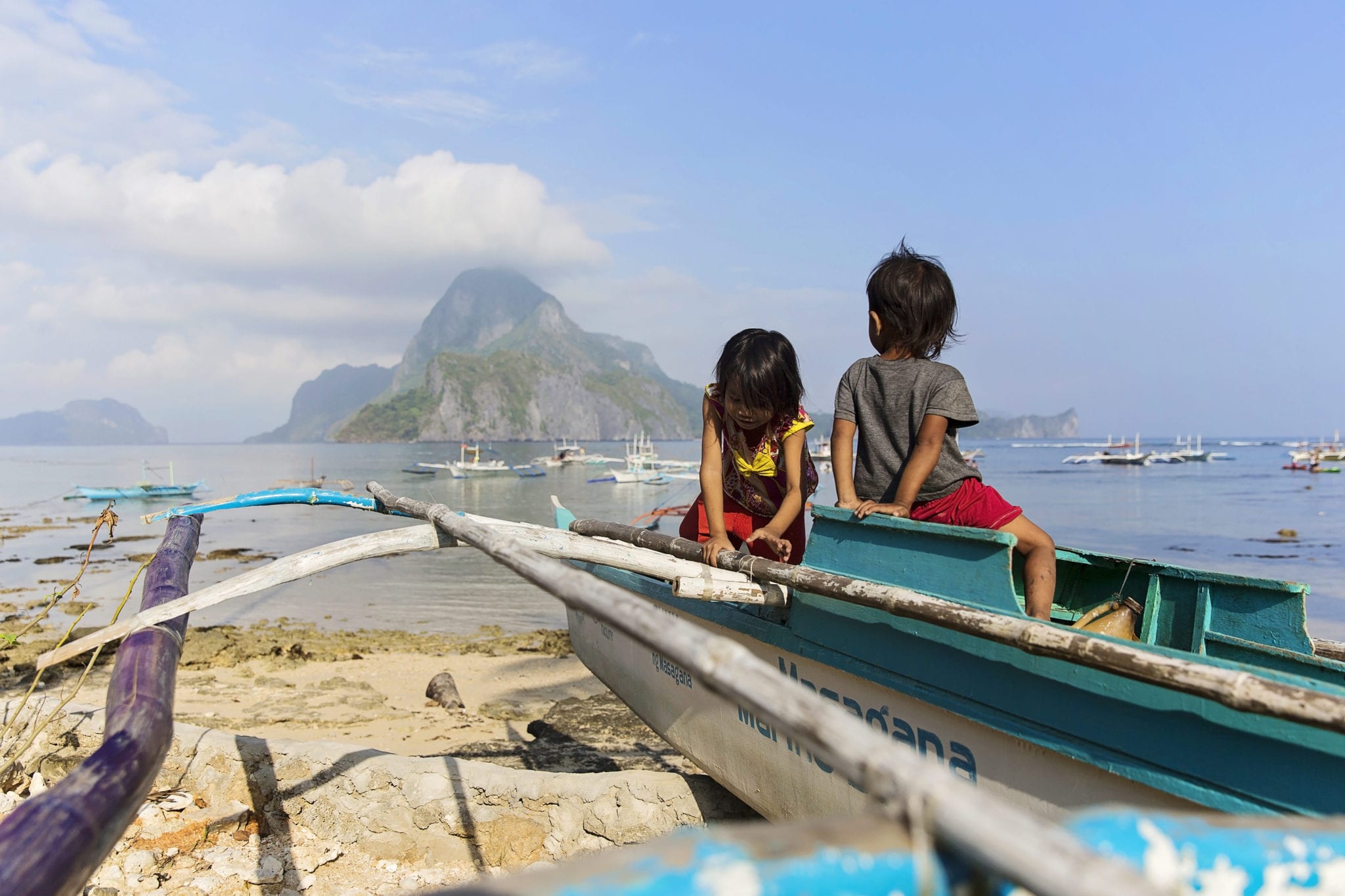 I’m sitting here on a gorgeously sunny afternoon, hanging out by our bungalow, mere feet from the crashing sea, under the flapping fronds of three soaring palms, while Rich chills out with his book in the hammock a couple of feet away, taking time for a swim break when the sun gets too warm. I can think of far worse places to sit while writing travel updates. :)
I’m sitting here on a gorgeously sunny afternoon, hanging out by our bungalow, mere feet from the crashing sea, under the flapping fronds of three soaring palms, while Rich chills out with his book in the hammock a couple of feet away, taking time for a swim break when the sun gets too warm. I can think of far worse places to sit while writing travel updates. :)
Jan 13-15
After a restless night courtesy of our rodent friend, we woke early to meet the ferry, uncertain as to what we’d be facing. It was with great relief that we learned that we were on a large, 80-passenger boat, and that the journey our fellow traveller had described was unusual – although the size of the boat was par for the course with certain ferry companies, the boat’s propeller had broken, and that had been the reason for the journey taking so long. I wasn’t sure that I found any comfort in that fact, but away we went…
We got settled on the top deck of the ferry and it immediately became clear that our journey would be nothing like that ill-fated one we’d heard about. Our boat motored along smoothly and we enjoyed a gorgeously sunny (and dry) afternoon, sprawled out on the deck amongst fellow travellers. The cool breeze was deceptive and the sun was stronger than I realised – despite my best efforts, I managed to get a pretty good sunburn. If raccoon eyes were to suddenly come into fashion, I’d definitely be leading the trend.
Pulling into El Nido harbour was a breathtaking experience. The islands in the Bacuit Archipelago, just like those off the coast of Coron, are limestone karst formations – like Halong Bay in Vietnam but, thankfully, without the raw sewage. The islands have this incredible tendency to end suddenly, creating soaring, sheer, craggy drops into the sea. El Nido harbour lies just below one such formation, and is a stunning location for a town. Unfortunately, in spite of its inspiring location (I read that Alex Garland lived in El Nido when he wrote The Beach), El Nido is a bit of a hole. Like Coron, it’s full of shops plying their trade to tourists – just more of them. There is an interesting imbalance in the tourists here: the vast majority are French or German; most are 30+; and there are plenty of Russians, who tend to be our least favourite type of tourist because of their tendency towards ignorance (Rich was flabbergasted and angered to see one Russian walking all over live coral during our boat trip) and arrogance.
From the port, we grabbed a trike – a motorbike built into a sort of overgrown sidecar with a roof over the whole thing – and asked to be taken to Antonio Pension. Imagine our confusion, then, when he drove us a few minutes down the road, stopped the trike, and ran off to talk to several other drivers. He clearly didn’t know where he was going. After consulting with the others, he came back and gestured down the beach and told us to walk. We took our bags and walked the seemingly endless journey to the guest house, part of which can only be done on the beach – awesome when it’s mid-afternoon and your camera bag alone weighs 15kg. It was with great relief when we FINALLY reached the guesthouse and discovered that the walls of our building were concrete. No rats! Then we turned around and noticed the 6-inch gap under the door… and resumed our habit of sealing anything that might be of interest to furry creatures into our drybag, just to be safe.
The guesthouse was great: the staff were content to leave us to it, we had plenty of room in the bathroom (goodbye, toilet-seat showers!), and possibly the most comfortable bed we’ve ever had in Asia – no Southeast Asia Hard Mattress Superstore shopping for these guys! As a bonus, they loaned me the necessary materials to prep mango-and-banana salads whenever I asked. :) We were a ways out of the town proper, but the 15 minute walk into town gave us some forced exercise to work off a bit of our Christmas weight. It also gave us a chance to learn that, in the absence of horns, motorbikes on the narrow coastal path just use a child who sits on the bike beside or in front of the driver and, with startling accuracy, shouts, “Beep! Beeeeeeep!” to alert you of the bike’s approach.
On our first full day in in El Nido, we met Daryl, our trike driver, who took us down the heavily-rutted obstacle course loosely known as a “road” out to Nacpan Beach, 20km and almost a full hour north of El Nido. Nacpan is 4km of unadulterated beach bliss. The sand is white, the beach is wide, the food is cheap and so is the accommodation – we heavily debated moving. There’s just enough of a surf break to do a little bodysurfing – or “bodydumping”, as is my specialty. :) We spent a few hours on this gorgeous stretch of sand and then wedged our two not-so-little Western bums back into the trike for the uncomfortable trip back to town, accompanied by my all-time least favourite soundtrack (okay, second only to the 80s love songs we listened to on our way to Nyungwe in Rwanda): 90s karaoke power ballads.
Again, we found ourselves spending an evening trawling the tour companies in search of a good island-hopping tour. We arrived in El Nido thinking that we wanted to do another overnight trip, but gradually decided that it wasn’t necessary and that the lovely woman from Midnight Sun, a tour company near our guesthouse, offered the most appealing option. Between the usual A-B-C-D offerings, she gave us an honest recommendation and said that we could do tour C with a little bit of A to make up for part of tour C being unavailable due to that section of the island and its beach being rented out for filming of the upcoming season of Survivor. We met at the shop in the morning and waited for the other pair who were to be on our boat…. for almost 40 minutes. When, at last, our little Filipina decided she’d waited long enough, she sent us off with Jimboy and Laki (although, from the significant scars on his brow and under his chin, I couldn’t help but wonder if his name was actually “Lucky”) to explore the Bacuit (“Bakit”) Archipelago.
What an incredible day! Helicopter Island proved to be a great spot for snorkelling – again, much of the coral has sustained damage from feet and poles, but there were some beautiful patches of stag, brain, and elephant ear coral in vibrant greens and deep purply-blues; the variety of fish was enough that, by the time I surfaced, my brain was overwhelmed with the effort of trying to remember what I’d seen in between pipefish and parrotfish, angels and wrasses. Floating there in the tepid sea waters, I looked at Rich and commented that this all feels a little surreal. I don’t know how we got lucky enough to lead the life we do, but I’m grateful for it. The Mantiloc shrine and abandoned hotel/convent/mystery building were slightly spooky, while Big and Small Lagoons each lived up to their titles, as did Hidden Lagoon. Hidden Lagoon, accessed by crawling through a hole in the rock wall that was periodically flooded by a surging wave, offered very little of interest once inside (other than finger-waving Asian tourists), but the process of actually scrambling through the rocks into the lagoon was quite fun. Our lunch spot, the name of which now escapes both of us, was a great one. The boys did a great job, as was the trend for the whole day, of finding a quieter stretch of sand in front of which to land the boat; while there were about eight boats further down the beach, we were joined by only two others. A quick bit of snorkelling revealed that the water was teeming with jellyfish, although there were very few with tentacles, so the stings felt more like the red ant bites in the DRC. Still, it was enough of a concern and a discomfort to drive me from the water, but there was enough interesting marine life to make Rich put up with the stings.
Of all of the stops we made that day, though, Secret Beach was by far the highlight for us. When we set off from lunch, we noticed three boats ahead of us who’d paused alongside an island. The coast of this island had the trademark soaring cliffs, so we knew that they weren’t planning on going ashore, but I thought that there might be a little inlet with a bay or something of interest midway up one of the cliffs. Each boat only paused for a minute or two, and then moved away, so my curiosity was well and truly piqued by the time we pulled up. The guys each took a keen interest in the coastline and then pointed at a TINY little keyhole opening in the rock face, through which a little glimmer of sand was visible. There was a beach back there! They gestured in a way that was clear: they wanted to know if we wanted to swim to the beach. We were initially hesitant. Waves were crashing against the rocks, there seemed to be quite a bit of surge, and the little hole filled with water every 10 waves or so. We asked if it was safe, they said yes. We watched a few moments more and checked with them again, and were given an affirmative response a second time. We grabbed life vests – because if I’m going to be knocked unconscious by a collision with rocks, I’d rather not sink immediately afterwards – and our snorkels, and jumped overboard. Thankfully, Jimboy jumped in with us, which did a great job of putting our minds at ease about what we were about to attempt.
It turned out to be significantly less harrowing than we expected; the opening was actually larger than it looked once we got closer, and the rocks – normally razor-sharp jagged pieces, were worn smooth by the crashing sea. Jimboy helped us through the hole and our passage was uneventful, save for a brief-but-entertaining moment when I started to get sucked back through the opening by the surge, but managed to recover and push forward again once I’d regained my foothold. Once it was clear that we weren’t at risk of being smashed into sharp rocks and sent to a watery death, I put my face down and was, quite literally, left awestruck by what I saw. The sea throughout the Philippines is astonishingly clear, even when dozens of metres offshore; the turquoise waters reveal countless coral growths and small schools of fish. When I stuck my face in this particular bit of water, I was greeted by a coral wall that rose up suddenly from the sea floor immediately inside the entrance to the lagoon, and so many fish that I hardly knew where to look. Hundreds of small silvery-blue fish darted just below the water’s surface; streaks of vibrant yellow, deep blue, Crayola purple and emerald green flitted past, less than a foot below me, while larger, more richly-coloured fish swam up the wall along its entire length. I’ve done a good few dives in various seas, but this was more breathtaking than much of what I’d seen before – perhaps purely because it was so unexpected, but also because this little wall was so densely populated.
We swam further into the lagoon and walked up onto the beach; ours would be the only footprints left in the sand that day, as no other boats joined us and none of the ones that followed in our wake ended up stopping there that day. We stood on a tiny patch of sand, surveying a completely secret lagoon no more than 70 feet in diameter, and I couldn’t get the smile off my face. I looked at Rich and quietly said, “This is quite possibly the coolest place we’ve ever been.” I was still smiling as, with the grace of a couple of beached walruses, we clambered back into the boat via the rickety little ladder strapped on with what looked like industrial-strength Gimp (hello, 1991!). I couldn’t get the image of that little place out of my mind for the rest of the tour.
We headed back across surprisingly smooth seas, given the dark clouds that had been chasing us all day, and I was once again struck by the beauty of these islands. Stark slate grey cliffs contrast with the jewel colours surrounding them: the cloudless blue sky and peacock blue sea that turns to turquoise when sand lurks below, and the vibrant green palms and grasses that grow atop the islands’ peaks and plateaus.
Once back in El Nido, we returned to the usual grind of finding somewhere appealing and affordable to eat – as well as being a tourist trap, El Nido is also much pricier for meals – and then packed our bags to prepare for our 7am departure for Port Barton, our final stop in the Philippines.
I can’t say that I’d recommend El Nido to anyone as a destination of choice, but it’s a necessary means to an end, and that end is very much worth the effort.
Grateful for: a snorkel and mask








